Benedict Cumberbatch The Current War
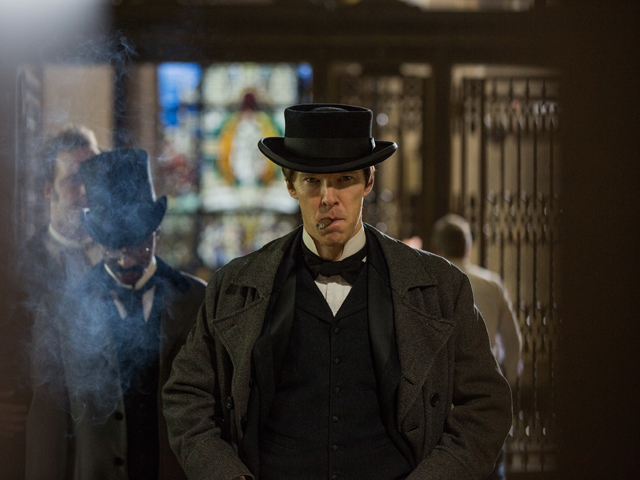
The Spark
Cast: Benedict Cumberbatch, Nicholas Hoult, Michael Shannon, Katherine Waterston, Tom Holland, Matthew Macfadyen, Tuppence Middleton
Director: Alfonso Gomez-Rejon
Genre: Biography, Drama
Synopsis: Winter, 1880. A train carries a group of New York fat cats to a field in the depths of the New Jersey countryside. Shrouded by darkness, a lone figure emerges: Thomas Alva Edison, illuminated only by the faint glow of his trademark cigar. Suddenly a switch is flicked, and the landscape is bathed in the glow of row upon row of outsized bulbs. Using his direct current system, the Wizard of Menlo Park has, seemingly, cast his greatest spell yet.
Now in Washington, Edison coaxes and cajoles the great financier J.P. Morgan to throw his money behind his invention. Instead, he finds himself in The White House with his wife Mary, children Dash and Dot, and his British personal secretary, Samuel Insull, showing off another invention, the Edison Phonograph. There, President Chester A. Arthur attempts to entice him to design weapons of war for the military. Edison is unequivocal. "The only device I shall never build is that which takes a human life," he tells Arthur.
Leaving the Oval Office without the funds he'd sought, Edison unveils his plan: to light up a square mile of Manhattan with his electrical globes and six giant dynamos. Insull is instructed to set up a new enterprise " Edison Electric " in New York.
Meanwhile, three hundred or so miles to the west, is rival industrialist George Westinghouse and his wife and confidante Marguerite. They hear of Edison's breakthrough and Westinghouse's interest is piqued. With Insull acting as go between, a meeting is arranged but a tired Edison snubs the engagement. The eager and openhearted Westinghouse is stung and this friendly competition takes on a decidedly more antagonistic tenor.
Back at his home and laboratory Menlo Park, New Jersey Edison he learns that Morgan will fund his project after all. As Edison lights up New York's Pearl Street in a fanfare of publicity and public clamor, Westinghouse muses over how he'll generate enough power to expand the grid across the city using direct current. So, too, does Nikola Tesla. The Serbian immigrant " a brilliant but impoverished inventor " offers his services, and his idea for alternating current (AC), to Edison. It will, he promises, send more electricity over longer distances. Edison believes AC to be too dangerous and unmanageable to harness, but hires Tesla, offering him a meager $10 a week to work at Menlo Park.
As Edison plots to expand his electricity across 12 US cities using DC, Westinghouse's AC system successfully sends electricity a mile, lighting up the town of Great Barrington, Massachusetts, and outraging his rival in the process. To Edison's annoyance, Westinghouse seems to be cracking it " and using his own invention, the bulb, too. Tesla offers to design a motor to power Edison's own AC system but is turned down flat. Edison believes too stubbornly in his own genius to course correct. The Serb leaves to set up his own company, Tesla Electric.
Instead, Edison takes the fight to Westinghouse. He smears him in the press, and even prank calls him using his phonograph, but succeeds only in redoubling his rival's efforts. With the Westinghouse Electric Company set up, and a new patent for his system submitted, the genteel industrialist steels himself for battle.
For Edison, the only solution is to work harder and drive his men more ferociously. Then tragedy strikes - his beloved wife, Mary, falls ill and dies. The inventor, disconsolate, buries himself ever-deeper into his work, even as Westinghouse's lighting finds favor with increasing numbers of towns around the country. Morgan counsels him to switch to AC; Edison again refuses. Seattle, Fort Worth, New Orleans… as Mary Edison is buried, city after city adopts Westinghouse's system. Money runs low.
The 1893 Chicago World's Fair puts Edison and Westinghouse head-to-head in a high-profile competition. Both seek to light up the city for the world-famous event. In the frenzy to invent a motor to boost his system, Westinghouse's loyal chief engineer Franklin Pope is killed. Rumors swiftly spread that alternating current is deadly after all. George Westinghouse resolves to overcome the loss and win the War of the Currents.
Edison, meanwhile, takes a final opportunity to discredit his rival by using a secretly-sourced Westinghouse generator to power the first electric chair. Westinghouse brings the matter to court and Edison claims that, while his rival's system is dangerous, 'Westinghousing' is the most humane way to execute those on death row. The two men meet, finally and briefly, on the steps of the Buffalo courthouse.
only Duped and defrauded by unscrupulous businessmen and reduced to digging ditches, Tesla finally meets Westinghouse in his dowdy hotel room. The two immediately hit it off, as Tesla outlines his vision for a new form of power that harnesses the energy of Niagara Falls. The like - minded men collaborate: one providing the AC system, the other the motor to magnify its power.
Using a private investigator, Westinghouse uncovers and publicizes Edison's scheme to discredit him via the electric chair. He wins the World Fair contract " and the War of the Currents " as the execution of a murderer, William Kemmler, ends in a grizzly, headline-grabbing fiasco.
Westinghouse is triumphant but remains a little-heralded figure; Edison is beaten but his fame and determination to innovate remain undimmed. He pours himself into the infant movie industry, setting up the Edison Motion Picture company, patenting the Kinetograph and making images dance.
The Current War
Release Date: March 19th, 2020
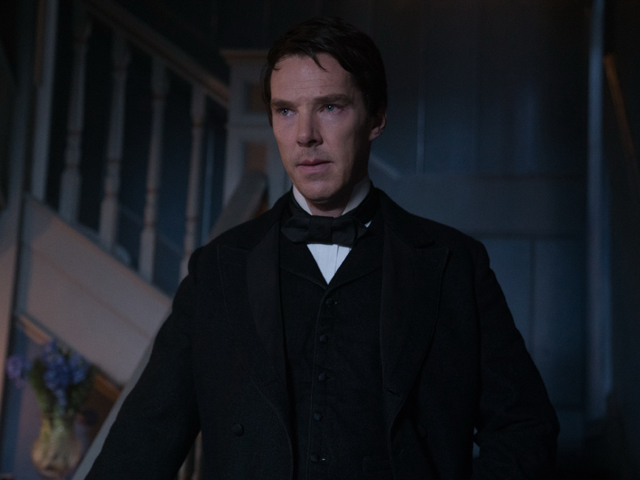 Making The Current War
Making The Current War
The Spark…
Not many screenplays have their genesis during the rush of a college orientation week. But that's exactly where The Current War began. On screenwriter Michael Mitnick's first day at Yale University's School of Drama, he was given a simple assignment: to bring an idea from history to class. "My mind flashed back to an Apple computers poster of Thomas Edison I'd had on my childhood bedroom wall," he remembers, adding with a laugh: "I'd picked [that poster] mainly because I thought Edison looked like a mad scientist." That first night in New Haven, he began researching the famous inventor. He quickly discovered that there was much more to his story than the invention of the lightbulb. "I stumbled upon 'The War of the Currents' " an epic battle between Edison and [industrialist/invention enthusiast] George Westinghouse to determine the world's standard of electricity," Mitnick says. The story took all sorts of unexpected, tragic and thrilling turns. There was a scurrilous smear campaign, the secret invention of the electric chair, the violent death of a man, and the advent of a unique scientific talent in Serbian immigrant Nikola Tesla. "I remember thinking, 'How did I not know this?'" he marvels. "Then it became a ten-year process of writing it, first as a musical and finally as a film."
The musical iteration enjoyed a brief run at Yale in 2008 but as his screenwriting and playwriting career took off, his Current War musical went by the wayside. But the story remained in the back of his mind.
"Ultimately, I wrote it as a straight-up drama. I used the places where there were songs to go deeper into [Edison] and [Westinghouse's] characters."
Completing The Circuit…
Mitnick's first draft began to come together as he delved further into these famous, but much misunderstood figures. "I had a long period of research," he remembers, "going through archives, newspapers, primary sources." Key reference books for his two " with Tesla, three " main characters were Francis Jones' 'Thomas Alva Edison', 'A life Of George Westinghouse' by Henry G. Prout, and Tesla's own autobiography, 'My Inventions.' Three books by a one-time Edison employee called Francis Jehl, 'Menlo Park Reminisces', offered invaluable, if partisan insights into life at Menlo Park. Mitnick also scoured Edison's extensive notebooks and journals, paid visits to the Library of Congress and Pittsburgh's history museum and enlisted the help of pre-eminent Edison historian Paul Israel.
Many drafts later, the final screenplay for The Current War made its way onto the prestigious Black List, where producer Timur Bekmambetov discovered it and purchased the rights from Mitnick. The son of an electrical engineer and a life-long tech aficionado, the saga of these three titans and the race to establish the pre-eminent electrical system spoke to Bekmambetov. "When we optioned the script in 2012, we didn't see it as a history lesson but rather so relevant to today's world," Bekmambetov says. "We've seen versions of their ingenuity, contentiousness and competing visions play out in Silicon Valley – Steve Jobs and Bill Gates, for instance. It's about innovation and new technologies AND about the responsibility that come s with that and the dichotomies. Edison, the genius who gave us light, also gave us the electric chair … but it's also about a rivalry of geniuses driven by both personal and civic motives. It also illustrates the tremendous, tectonic shifts their work brought to all our lives that echoes today – ultimately, electricity was not just about light and power but changed our entire lives in almost every way."
Bekmambetov entered into an agreement with the now defunct Weinstein Company. Benedict Cumberbatch signed on to play Edison, entranced by the screenplay right from its opening scene. In it, Edison " the so-called 'Wizard of Menlo Park' " impresses a gathering of New York magnates and influencers by lighting up a wintry field with giant bulbs. "All you see i s this wave of furs and silk-top hats and spats getting covered in mud," says Cumberbatch, reliving his first impression. "Then in the distance there's this glowing ember of a cigar. Then the flick of the switch and this pop and crunch of all these bulbs coming on. It was the idea of this man in a muddy field playing God " making light out of dark." It was, he remembers, "a dazzler" of an opening.
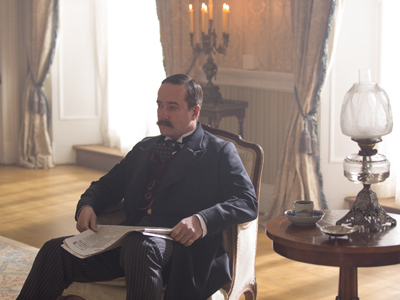 With Cumberbatch in place, Bekmambetov brought the script to director Alfonso Gomez-Rejon, (Me And Earl And The Dying Girl). Like Bekmambetov, the battle royale between Edison, Westinghouse and, later, Tesla fascinated him. "This idea of the nature of success and how far a man would go to win, and how far will you go to be remembered was very compelling and underscored the very human nature of these legendary figures," says Gomez-Rejon.
With Cumberbatch in place, Bekmambetov brought the script to director Alfonso Gomez-Rejon, (Me And Earl And The Dying Girl). Like Bekmambetov, the battle royale between Edison, Westinghouse and, later, Tesla fascinated him. "This idea of the nature of success and how far a man would go to win, and how far will you go to be remembered was very compelling and underscored the very human nature of these legendary figures," says Gomez-Rejon.
only Gomez-Rejon also recognized a thematic connection between The Current War and Me And Earl And The Dying Girl. "Earl was an attempt to understand death through creativity; keeping a loved one alive, discovering new layers about them, new stories, through the work they leave behind (the carved books from the end of that film)" he adds, "but The Current War looked beyond that. Rebirth through creativity, invention. Edison's inventions and 'branding' suggest what kind of concern he might have had for his legacy. It's the nature of any inventor to crave permanence. They seek solutions, and solutions are, by definition, lasting. It's an obvious contrast to Westinghouse's seeming disinterest in the preservation of his image in any form whatsoever. He chose anonymity, and leaving the world a better place. They each seem to occupy two distinct poles of exhibition. Westinghouse is the factory man, the man of the people"he is the Crowd. Edison is bravado, as much a name as a man "he is the Show. The Crowd and the Show. Humility vs. Ego," Gomez-Rejon remarks. "Now add the electric chair to the story, and the responsibility that comes with invention -- and I couldn't wait to make this movie."
Flicking The Switch…
The screenwriter recalls his first meeting with The Current War's director, Alfonso GomezRejon. "We talked about what drew each of us to the story," says Mitnick. "One of the things was that these people were changing the world. We think of Thomas Edison as this virtuoso who 'invented' the lightbulb. What these guys [really] invented was the idea of not playing by the rules."
Their maverick approach influenced Gomez-Rejon's approach to the material, which was certainly not a nostalgic look back. "These men are futurists and I wanted it to be in sync with the spontaneity of their ideas."
"The reason why we love Alfonso for the movie was that he clearly demonstrated with Me and Earl and the Dying Girl his deft ability to convey emotion and there is a real emotional underpinning to this story," Bekmambetov says. "Equally important is that this is a very American movie and Alfonso deeply understood and embraced this. He wanted it to feel like a contemporary movie, not a period piece. He had strong vision as to how to achieve that from the visuals to the music to the pacing."
Gomez-Rejon took inspiration from the tumultuous changes of the late 19th century, the Gilded Age. "Everything that was happening in the world at that time " art, music " was evolving quickly," he says.
Producer Basil Iwanyk notes that Gomez-Rejon turned to modern inspirations too. "Alfonso connected with it on a very rock 'n' roll level," he explains. "He saw this movie like Mick Jagger and David Bowie, or Steve Jobs and Elon Musk, going toe-to-toe."
Because Edison and Westinghouse largely operated on parallel tracks, with Tesla buffeted between them, the two main characters remain apart for most of the movie. The practical implications of that structure meant that the shoot logically broke down into two parts. "I shot only two movies, basically," says Gomez-Rejon. "It was challenging - you get into a rhythm, and overnight it's a different cast, a different setting, a different everything. But it was also very energizing."
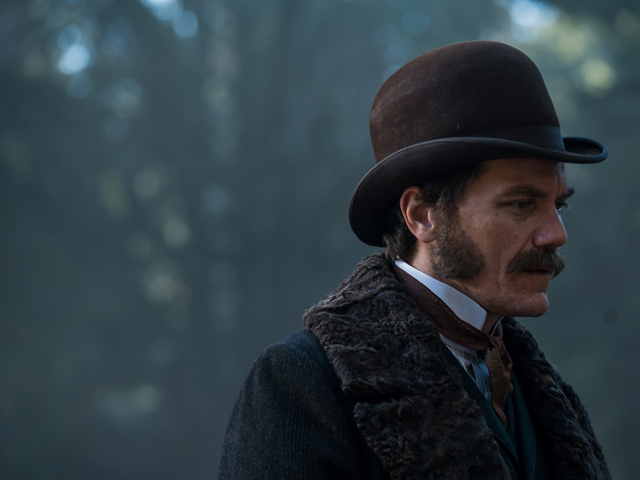 The Characters
The Characters Thomas Edison (Benedict Cumberbatch)
For Gomez-Rejon, Cumberbatch was perfect for the role of Edison. "His curiosity was so infectious and his energy made the set feel so alive. And he went so effortlessly into the dark side of Edison."
Cumberbatch speaks equally warmly of their collaboration. "Anytime I felt insecurity over the accent or being far away from the experience of Edison and straying into the territory of doing something safe, he'd encourage me to get outside my comfort zone. He'd say : 'C'mon man, you don't need to worry. Just go for it.' I felt I didn't need to entertain or explain or show; I could just be this character. I absolutely loved working with him," reflects Cumberbatch.
Familiar with Edison's broader biography, Cumberbatch quickly discovered a life overflowing with nuance and contradiction. "I think I'd been sold the idea of him as the inventor of the modern age in America, rather than the complexities of what that involved," he says.
Cumberbatch embodied Edison's fabled intelligence, showmanship, ruthlessness and creativity but also captured another, less renowned aspect: his human side. Edison unde rstood the power of celebrity and used his fame to great and calculated advantage, but he also suffered greatly after the unexpected death of his wife (later in life, Edison's invention of the phonograph, allowed him to keep his wife's memory alive through her voice recordings).
Of course, Edison's competitive, uncompromising worldview leads him into murky terrain as the film unfolds. His need to defeat Westinghouse will lead him to betray his firmest principle: never help take a life. "The irony of that guy helping create the electric chair to win the War of the Currents is really sad," says producer Iwanyk. "Edison disregards his moral compass early in the film and loses his way."
Cumberbatch regards Edison as the "fallen hero" of the story. "It's about stripping the man from his image of himself as a god of industry " a Steve Jobs or Bill Gates or Mark Zuckerberg " into being an embittered loser. But then he dusts himself off and he's off again in search of a new prize. The wheels don't stop turning in his head just because he's fixated with one battle and fighting court cases over patents, he's still doing the good stuff in tandem. He's a remarkable man with many, many human flaws."
George Westinghouse (Michael Shannon)
For the role of George Westinghouse, Gomez-Rejon turned to another Oscar nominee, Michael Shannon. "I'd just seen him in Long Day's Journey Into Night on Broadway and met him briefly backstage," says the director. "I'd been a fan of his for many, many years. There's some thing singular about what he does but I had never seen him tackle someone like Westinghouse and it was exciting to see him go places I hadn't seen before."
When the pair first met, Gomez-Rejon shared an antique book about Westinghouse. "It wasn't even a biography," says Shannon, "more a kind of eulogy about what a great man he was and it was a fascinating character study. He seemed to be a gentle and thoughtful individual. I'm not really good at picking out heroes, but he was something."
Unlike Edison, Westinghouse didn't court celebrity or try to reinvent himself as a brand. Only 13 pictures of Westinghouse survive, and he also burnt his papers before his death in 1914. Consequently, his fame has dimmed, but in a way, his reticence and innate modesty allowed Shannon some creative freedom.
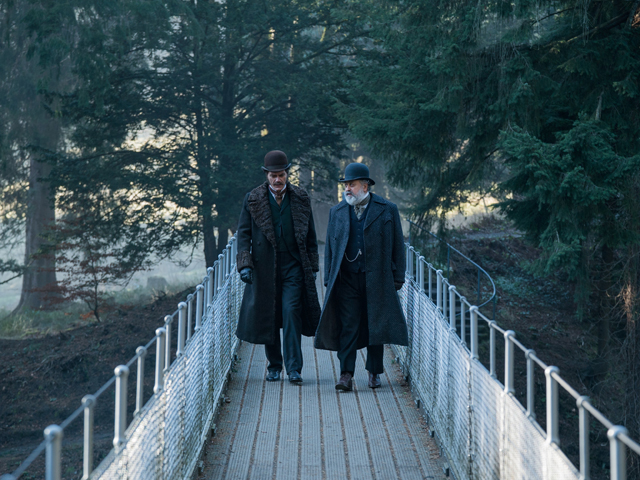 "Many times, famous people come with the baggage of pre-conceived notions and Westinghouse did not," says Shannon. "No matter who you play, whether it's a real person or not, they're still a figment of your imagination."
"Many times, famous people come with the baggage of pre-conceived notions and Westinghouse did not," says Shannon. "No matter who you play, whether it's a real person or not, they're still a figment of your imagination." There was a yin and yang to the actors, as well as their characters. "Edison is a showy part and we needed to find a Westinghouse who could go toe-to-toe with Benedict as an actor and wasn't intimidated by the role," explains Iwanyk. "It mirrors the movie: Thomas Edison takes up a lot of space in the room; Westinghouse is the more quiet, noble character."
"Michael is so different from Benedict " one's AC, one's DC in their process and approach " and that was a very exciting tension," says Gomez-Rejon. "It was a pairing I really believed in."
Edison and Westinghouse barely met in real life " and the movie reflects that. Mitnick took on the challenge of maintaining intense rivalry in which the two rivals share only two scenes. "I had to take on a model closer to Michael Mann's Heat, where you have two people who despise each other and who never really get to meet," he explains. "In reality, Westinghouse and Edison did meet, but most of their battle was waged via reporters as front-page news." "We didn't spend a lot of time together," says Shannon of Cumberbatch, "but there is a scene we have together towards the end of the movie and it's a wonderful, well -written scene and kind of the moral of the story. That was a lot of fun to shoot."
Nikola Tesla (Nicholas Hoult)
The role of Serbian inventor Nikola Tesla, the immigrant who ultimately determines the outcome of the War of the Currents, is played by Nicolas Hoult.
"Reading the script for the first time I thought: 'Wow, I didn't know how it all played out!'" Hoult explains. "Westinghouse and Tesla were the ones that essentially provided the electricity we use today, whereas I'd mistakenly thought it was Edison. It was educational."
Initially Hoult as Tesla was only supposed to be a brief cameo in the film.
"I met up with Alfonso and we spoke about the character and that they were going to write more about how his journey intertwined with Edison and Westinghouse," says Hoult. "Alfonso thought he could be such a fun role."
The actor didn't take much persuading. "To work with Michael and Benedict, two of my favorite actors, and being a fan of Me And Earl And The Dying Girl made it a very exciting prospect," he explains. "He was very different to any character I'd played before."
Hoult read Tesla's autobiography as part of his research for the role. "He was a fascinating man," he says. "He was ethereal and otherworldly and brilliant, and he had quite a rough go of things. He felt like he was from a different time and he could see so far into the future." Cumberbatch concurs, adding, "Tesla was the genius among them," he says. "Where Edison and Westinghouse could see ten years into the future, he could see a hundred."
Tesla's preternatural vision deeply impressed Hoult. "We found a quote where Tesla was talking about a time when we'd all have screens where we'd be able to see each other around the world," remembers Hoult.
Dialect coach Sarah Shepherd, who also worked with Cumberbatch to capture Thomas Edison's American accent, helped Hoult master Tesla's East European drawl. "Obviously, it's my first time doing [that kind of accent]," says Hoult, "but Sarah was fantastic. Alfonso didn't want the accent to sound Russian or like a Bond villain, and she was there on set to help. Ultimately, you do whatever you think works and just go for it."
There was some science homework, too. "Benedict and I had a science lesson for this," Hoult says. "We started out asking questions larger than we could ever comprehend and then going backwards until we could understand what was going on." In a few hours, the two actors could get under the skin of their more technical dialogue. "It's important not just to be a blank slate saying things you don't understand," says Hoult.
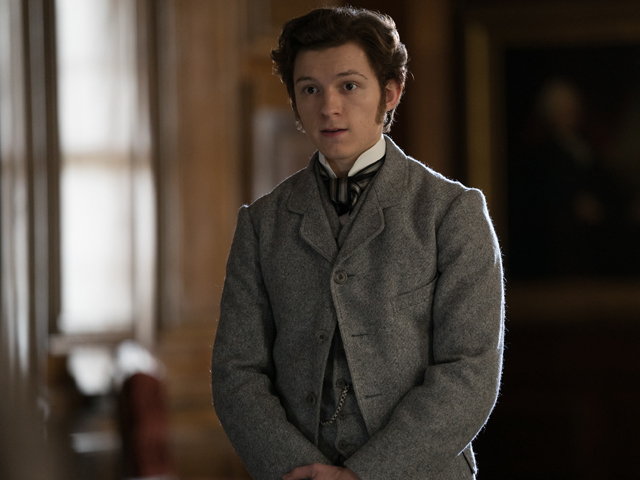 Samuel Insull (Tom Holland)
Samuel Insull (Tom Holland)Tom Holland plays Edison's young confidant and personal secretary, Samuel Insull. Holland had met the director for a coffee in 2012, fresh from his breakthrough performance in The Impossible.
"Tom was so young at the time, he had his mother with him," recalls Gomez-Rejon, "He's such an extraordinary actor"he was definitely who I hoped for this part."
A fan of Me, Earl And The Dying Girl, Holland responded immediately to The Current War screenplay. "It's a fantastic story – I had no idea it even existed " and I was intrigued to find out more about the character," says Holland. "I, of course, wanted to work with Alfonso and once he told me the cast it was a no-brainer."
Unlike his fellow Brits in the cast, Holland didn't have to adopt an American acce nt for the role. "Samuel Insull is a kid who grew up in Putney, then moved to Chicago and New York, so it was very interesting to try to keep that British spirit going throughout my performance," explains Holland. "For me, especially, when I come out to America, my accent slowly to started to change and I say things in different ways. Samuel Insull was the complete opposite of that: he stuck to his guns and kept his Britishisms."
Many of Holland's scenes are with Cumberbatch and the pair swiftly developed a rich rapport that helped deepen the dynamic of their characters.
"There's a great affinity between the two," says Cumberbatch. "It's more of a father-son relationship."
Staunchly loyal to Edison but prepared to stand up to him, Insull adds an intriguing dimension to The Current War. "There is a bit of steamrolling at the beginning," notes Cumberbatch of their relationship, "but Samuel is a formidable guy and he gives as good as he gets in a couple of scenes."
Holland remembers one of those scenes particularly vividly. "There was a scene where Insull is really pushing back, so there's little old me telling Benedict Cumberbatch he's wrong and in one of the takes Benedict shouted at me," he charts. "I jumped out of my socks. I was so scared. But it was exhilarating and one of my favorite takes."
Mary Edison (Tuppence Middleton)
Edison's smart, compassionate wife Mary is a key figure in the story. Played by British actress Tuppence Middleton, she's more than just 'the woman behind the man,' the desi gnation of many women of that time period.
"I wanted her to be quite a forward-thinking woman," explains Middleton. "She met Edison when she was working for him " she would have been 16 or 17 " and for her to have been working at that time in history, that's quite a modern woman. She was a tough lady and didn't suffer fools, and I wanted that to come across. She loved him and her family, and she forgives his emotional flaws and glitches."
Middleton's casting owed plenty to the brief but pivotal scene she'd shared with Cumberbatch in their codebreaking thriller, The Imitation Game and he advocated for her to play his onscreen wife in The Current War.
"There's a quiet strength and intelligence to Mary Edison and you need an actress of real depth to carry that off and having worked with Tuppence, I knew she could handle it beautifully," he says.
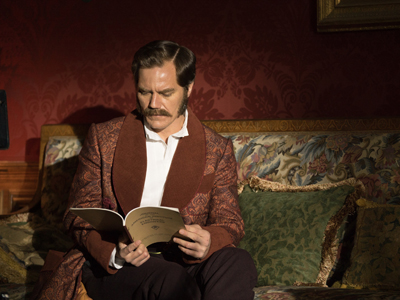 Middleton returns the compliment. "What makes Benedict amazing for these very intelligent, cerebral characters, is that he's very quick-thinking," she notes. "He always brings something new every scene."
Middleton returns the compliment. "What makes Benedict amazing for these very intelligent, cerebral characters, is that he's very quick-thinking," she notes. "He always brings something new every scene." Middleton was delighted that the script allowed exploration into Edison's home life, a sanctuary away from the politics and power plays of his business world. And it was her first time playing a mother.
"We wanted to show more of his family side," she stresses. "His wife and kids were a real support for him." Edison's interactions with his children, Dot (Sophia Ally) and Dash (Woody Norman), show his playful side.
"It was really important for us to show that lightness, it gives context and contrast to his professional life," says the actress. "Their family tradition of corresponding in Morse code and nicknaming his kids Dot and Dash were really sweet touches."
Tragically, Mary Edison would die of a brain tumor aged only 29. The event left Edison both guilt and grief-stricken. "We tried to do her death justice," recounts Middleton, "but also to underscore that feeling that it was too soon and too quick, and unfair. [We didn't want to] overdo it or 'play' the brain tumor. Because there wasn't a huge number of scenes to show what was happening to her, we had to figure out a way to show it that didn't feel too sudden or rushed."
Marguerite Westinghouse (Katherine Waterston)
Katherine Waterhouse plays Marguerite Westinghouse, the lively, outgoing counterpoint to her introverted husband.
"I'd seen Katherine in the Paul Thomas Anderson film [Inherent Vice] and I was a fan," says Gomez-Rejon. "She and Michael Shannon just seemed like a great rock 'n' roll couple."
Unbeknownst to their director, Waterston and Shannon were already friends. "I've known Katherine for years," says Shannon. "We made a movie called State Like Sleep, and I knew her from doing theatre in New York City. Marguerite was such a big part of George's life. It was a lovely relationship and it was great to have a prior relationship with Katherine and to work with her again."
It was a canny casting. "Michael and Katherine look amazing together: tall, stoic but loose and modern," says Gomez-Rejon. "There's a warmth and chemistry between them that was effortless."
Waterston also connected with Marguerite on a personal level.
"When we Skyped about the role, she said it reminded her of her grandmother," Gomez-Rejon says. "She'd been one of those women who were feminists before the term even existed." Katherine, he adds, offered "a very striking, regal yet accessible quality" as Westinghouse's wife.
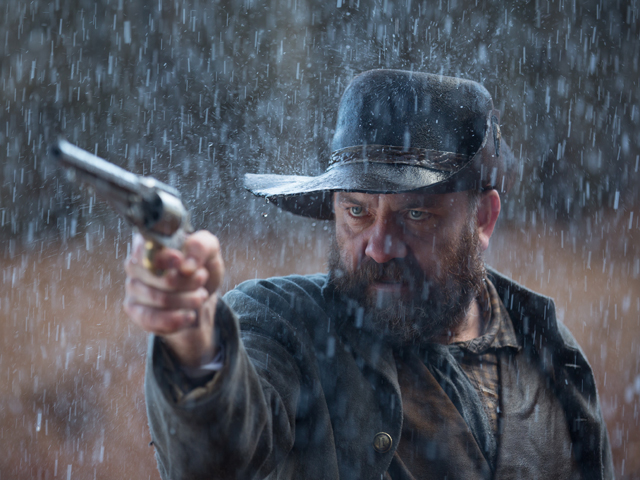 Creating The World
Creating The WorldLights, Camera, Action…
Gomez-Rejon reunited his Me And Earl And The Dying Girl cinematographer, Chung-hoon Chung and they designed a visual language that was energetic and modern, reflecting the revolutionary ideas and inventions of the protagonists. Shooting with an Alexa XT Plus, they both relied on their established creative shorthand. "We don't need to talk much on set anymore," says Chung. "We understand each other without saying much."
"Alfonso and Chung's cinematography and staging of the drama felt incredibly fresh," enthuses Cumberbatch. Their snap pans, zooms, oners and crane shoots were all in service of the story. "He got the beating heart of every single one of these characters," the actor adds.
"Alfonso was always pushing the boundaries in the way he used the camera," says Middleton, "so every day was really educational for me. I'd go in to watch on days when I wasn't filming."
The Locations
The initial plan was to shoot The Current War in America, using several locations around Westinghouse's hometown of Pittsburgh. But modern-day Pittsburgh does not resemble its 19th century predecessor. In the summer of 2016, Gomez-Rejon flew across the Atlantic to scout possible locations in the UK and found his base.
"We realised all the possibilities in England," he says. "In the process of scouting, I fell in love with London. Everything just worked out."
Nevertheless, recreating late 19th century American locations in 21st century England required ingenuity. Production designer Jan Roelfs set to work with his director recreating the story's real-life settings in a variety of locations around England, and in studios in Leavesden outside London. Roelfs didn't seek to create slavish facsimiles of the real locations. "It's more about 'What do you want to say?' and 'How do you want to develop the atmosphere around the characters?" Roelfs explains.
The film's field-set opening was filmed in a remote corner of Leavesden's backlot, Roelf's team reconstructed Edison's house on a soundstage. The versatile Leavesden was also where most of the movie's train scenes were shot. "We rented a train in really bad shape from Bluebell [train yard] near Brighton and rebuilt it there," says Roelfs. "We used it for three different trains, using different interiors and painting each side different colors. We cut big holes in it to get the equipment in, upholstered it and made furniture for it, until it looked like what we wanted."
The stately home of Cragside, an hour north of Newcastle, was used for Westinghouse's estate, Solitude. "It's beautifully set in the forest," says Roelfs, "and we shot the re for a week."
Meanwhile, Royal Gunpowder Mills at Waltham Abbey in Essex became home to Edison's lab which often required Edison-like feats of engineering. "We built between ten and 15 huge dynamos and transformers for Edison's lab," he says. "We had to go into the research and figure out what scale to make them." Designing Edison's bulbs and the electric chair demanded historical accuracy, too. "With certain things you can't take liberties," stresses the production designer. "We copied the key details of the electric chair, and the lightbulbs were made exactly the way he made them. We used etchings and newspaper clippings and researchers from the Thomas Edison labs in the US."
One of the bigger challenges was replicating the movie's Buffalo courtroom in England. "It was the one set that was impossible to find because of the nature of British and American courtrooms," admits Gomez-Rejon. So Central London's grand Freemasons' Hall was selected. "It was an empty hall," remembers Gomez-Rejon, "before Jan and his team transformed it into a 19th century seat of justice."
The biggest challenge of all, though, was capturing the scale and spectacle of the Chicago World's Fair " a five-month-long extravaganza of invention in 1893 that introduced the world to the zipper, Wrigley's Gum, Crackerjack and, of course, Westinghouse's alternating current. Using exterior shots of London's Alexandra Palace and interiors filmed at the Brighton Pavilion, stitched together with VFX and animated montages of colorized black-and-white photography, the movie's World's Fair offers a suitably grand setting for its climactic events.
"We worked really hard to get the Brighton Pavilion in for the World's Fair, because they don't let filming happen there a lot," says Roelfs. "We took the whole banquet table out of the banquet room and put a Chinese pavilion in there, with gold floors and bamboo railings and calligraphy. The people there were, like, 'Holy moly, what happened here?'"
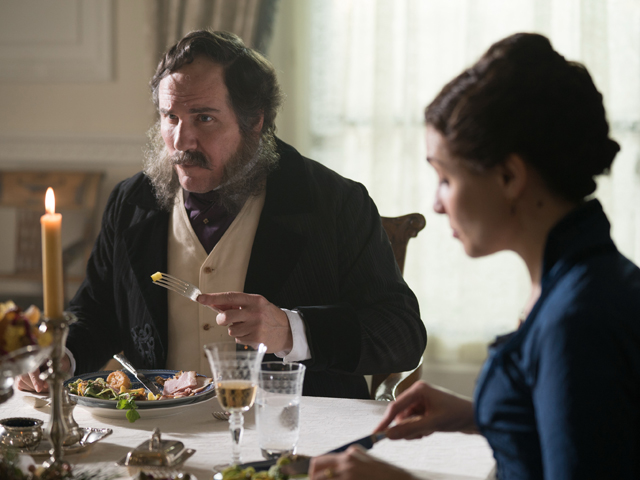 The Clothes
The Clothes The job of creating the film's intricate, expressive period wardrobe fell to Oscar-nominated costume designer Michael Wilkinson (American Hustle, Man of Steel). Gomez-Rejon's fresh approach captured the designer's imagination.
"Alfonso's vision was very intriguing to me," he says, "telling a slice of history in a modern, passionate, engaging way."
Gomez-Rejon offered a photographic look book as a starting point, using references as diverse as Bob Dylan, David Bowie and Silicone Valley entrepreneurs Mark Zuckerberg and Elon Musk.
"We wanted to avoid a Victorian history lesson--we tried give [the clothes] a modern vibe while being true to the period," says Wilkinson.
The story's 13-year span added to the task. "The film takes place over 12 or 13 years – 1880 to 1893 – so each character had quite the closet," says Wilkinson. "We also had 16 day-players and about 100 extras." Dealers in Victorian costumes provided some of the outfits " though mostly as references to work from " but the rest had to be created from scratch.
They used portraits and photographic references of Edison as inspiration, but had creative freedom away from the frock coats and formalwear of his public persona. "We wanted to show the side of him that he never really allowed to be photographed," Wilkinson explains, "which was the more vulnerable, domestic guy who was trying to be a father and hold onto his relationship with his wife. We wanted to show the cracks in the armor."
As for Westinghouse, the wardrobe hinted at the what lay beneath the restrained surface. "I wanted to show that there was an inner life and a passion behind the façade ," Wilkinson says. Working with the two leads was "fascinating", says Wilkinson. "Benedict was very involved in choice of fabrics and silhouette, and in expressing the passing of time, so all the details were very important to him. He really liked the idea of discovering the man behind the portraits." Shannon, by contrast, was less hands-on. "He was more trusting and a little less involved," says the designer, "but he was happy to take my guidance."
And Tesla? "Alfonso referred to him as 'The Man Who Fell to Earth' (the Nicholas Roeg film)," says Wilkinson. "He was extremely formal, always turning up to work in morning coats, spats, top hat and gloves, whereas Edison was famous for being crumpled and scruffy."
The thick, comparatively rigid fabrics of the period meant the costumes were often heavy. "It took a little getting used to for the actors," says Wilkinson. "I was very relieved that we were filming in the middle of winter."
Tuppence Middleton and Katherine Waterston endured the additional horrors of "extremely uncomfortable" tight-lacing corsets. "Don't eat too much lunch" is Middleton's advice for successful corset acting. "Also, sit down a lot, otherwise it restricts your breathing, and don't rush around too much."
Long petticoats, billowing skirts, big bustles and heels, all late-19th century staples, were key components in the wardrobes Wilkinson designed for Marguerite Westinghouse and Mary Edison. "They both loved and hated the clothes," cedes Wilkinson of the two actresses. "They had an interesting relationship with them, like the women of the period."
The results, though, dazzled them. "Michael did an incredible job," raves Middleton. The designer's proudest achievement on the movie was the 14 costumes he created for Marguerite Westinghouse. "She was well known for enjoying all the fine things in life," says Wilkinson. "She traveled to Paris every year to get the latest fashions, so I was able to show the different sleeve shapes, skirt shapes, the different combinations of colors and textures over the 14 years [of the film]. The bold, black-and-white striped dress that she wears to the World's Fair was one of my favorites, but I had lots of fun working with Katherine. She's super-smart and had lots of interesting input into the look of her character."
Tom Holland was also an admirer of the wardrobe. "I think I was born at the wrong time," he laughs. "The fashion of those days is so much cooler than what we have now. People took such pride in their clothes. There was no version of throwing on some sweatpants and a T-shirt; it was either a three-piece suit or nothing. I love clothes, so I think I would have enjoyed living in those days."
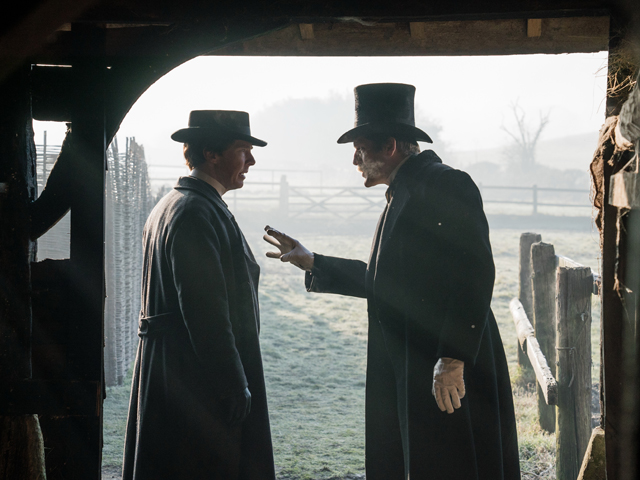 The Looks
The Looks Charged with creating the characters' individual looks was make-up and hair designer Sharon Martin. In truth, the job involved much more of the latter than the former. "It's one of the jobs I've used the least make-up on," she says. "We just went along with the skin as it was, and the lighting was so beautiful, I didn't want people to look too perfect. I used a lot of hair, a lot of glue, a lot of J Crew pomade, but actual make-up, nope, we didn't need that."
Following Gomez-Rejon's lead, Martin even listened to the music of Patti Smith to get in synch with the mood of the film. The director encouraged her to push the looks just a little further than the average period drama. "They wouldn't look out of place in Hackney today. We kept to the quirkiness of that time."
As you'd expect from the Victorian setting, there's plenty of splendid facial hair on display in The Current War. Some of the cast grew their own; some enlisted Martin's help. Because he came straight from a role in which he'd been clean-shaven, Shannon, who sports a formidable moustache and sideburns in the film, needed both applied daily. "It can be a hassle, but Sharon made it a very pleasant experience," he says.
Tom Holland admits that having Insull's mutton chops applied was an uncomfortable process " at least, at first. "The sticking-on of the sideburns was probably the most uncomfortable thing ever," he says, "but once they were on it wasn't all that bad. They did look good though, so it was well worth it."
The Current War
Release Date: March 19th, 2020
MORE



